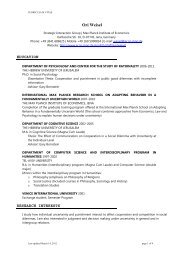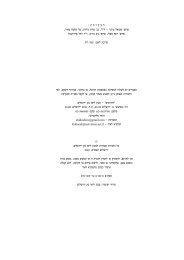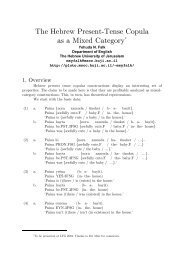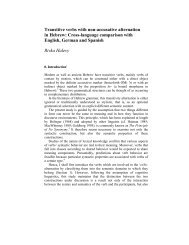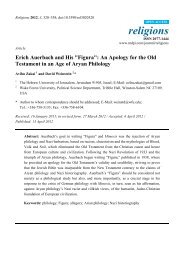The Federal Reserve May Be Politically ... - Pluto Huji Ac Il
The Federal Reserve May Be Politically ... - Pluto Huji Ac Il
The Federal Reserve May Be Politically ... - Pluto Huji Ac Il
You also want an ePaper? Increase the reach of your titles
YUMPU automatically turns print PDFs into web optimized ePapers that Google loves.
πE + bπED) ought to be positive). It is easy to see that in Table 3 the sum of the<br />
coefficients for Election × π and Democrat × Election × π is positive.<br />
Figure 5 plots equations 2 and 3 along with 95% condence intervals for the four<br />
equations in Table 3 - which differ only in the measure for ination used. e positive<br />
slopes on the gray lines suggest that, as the election approaches, the Fed becomes<br />
an ination hawk if a Democrat is in office. e negative slope on the black lines<br />
suggest that the association between interest rates and ination converges to zero as<br />
Republican incumbents near re-election. e slope parameters in 2 and 3 will differ<br />
by the value of the Democrat × Election × π coefficient in Table 3. Note that this<br />
is consistently positive and statistically signicant except where the Cleveland Fed’s<br />
measure of expected ination is used.<br />
Some details depend on the measure of ination used. When ination or expected<br />
ination based on household survey are used, there is a signicant and positive<br />
relationship between ination and interest rates in the later portion of a Democratic<br />
administration. is is not the case under Republicans. 7 When either the survey<br />
of nancial professionals or the Cleveland Fed’s model-based variable are used to<br />
measure expected ination, there is a statistically signicant link between ination<br />
and interest rates only when Democrats control the White House. Whichever set<br />
of measures are used, the Fed appears to be a conditional ination hawk. e top<br />
panels of Figure 5 suggest that the Fed turns off its responsiveness to ination when<br />
Republicans are facing re-election, and turns on its responsivenss to ination when<br />
Democrats are facing re-election. e bottom panels suggest that the Fed places little<br />
or no weight on hitting its ination target when Republicans are in office, but is quite<br />
sensitive to ination when Democrats are in office - especially as elections approach.<br />
Our model also makes conditional statements about the relationship between interest<br />
rates and the output gap, but the modifying effect of party operates differently.<br />
When the Fed acts as an ination hawk it places less weight on hitting its ination<br />
target. Under such conditions, we expect the Fed to be relatively insensitive to the<br />
output gap as it shis its attention toward ination. Consequently we should observe<br />
a weakening of the relationship between interest rates and the output gap when<br />
Democrats are in office and the election draws near. Conversely, the Fed should react<br />
strongly to the output gap when elections approach and the incumbent is Republican.<br />
Figure 8 reports lines analogous to equations 2 and 3 for the effect of the output<br />
gap on interest rates along with 95% condence intervals. e black lines show that,<br />
regardless of how ination is measured, interest rates are positively associated with<br />
the output gap in pre-electoral periods. e coefficient on Election×Y gap in Table 3<br />
7 Conversely, there is a signicant and positive relationship between ination and interest rates in<br />
the post electoral period only when Republicans are in office. is is consistent with the idea that the<br />
Fed deliberately contracts the economy early in a Republican administration so that the economy will<br />
bounce back in time for elections.<br />
14



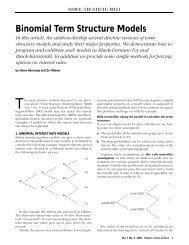
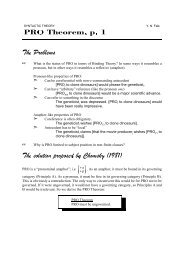
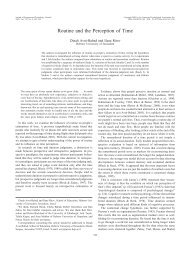
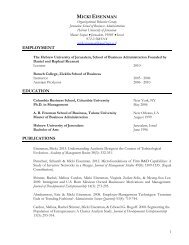
![CV [PDF] - Pluto Huji Ac Il](https://img.yumpu.com/18174585/1/190x245/cv-pdf-pluto-huji-ac-il.jpg?quality=85)

